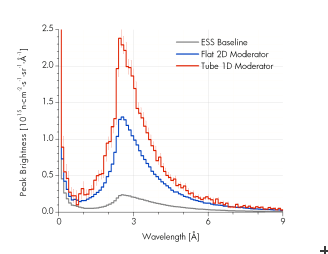Copyright 2012 neutronsources.org | All rights reserved. | Powered by FRM II | Imprint / Privacy Policy
An order of magnitude increase in moderator cold neutron brightness might offer unprecedented performance for neutron scattering experiments
19/02/2014
Neutron scattering experiments need beams with high fluxes within the required angular divergence at the samples. By Liouville’s theorem the upper limit of this quantity is determined by the brightness of the neutron emitting moderator, which tells how many neutrons are emitted from a given surface element into a given solid angle around a given direction. The flux on the sample is then determined by the brilliance transfer coefficient, characterizing the efficiency of the beam delivery neutron optical systems such as guides coated by supermirrors.
In design optimization study a team of ESS has discovered that liquid para-hydrogen coupled cold neutron moderators can deliver 3 – 10 times higher neutron brightness at a spallation neutron source if they take the form of a flat, quasi 2-dimensional disc, or a quasi 1-dimensional tube, in contrast to the conventional more voluminous shapes used by now both at spallation and reactor sources reactors.
Low-dimensional moderators are capable of providing unprecedented brightness, as shown in the figure.
The physical reasons for such behavior in low-dimensional moderators are multiple:
- The main factor is that the mean free path of thermal neutrons in liquid para-H2 is of the order of 1 cm and for cold neutrons it is above 10 cm. Thus the thermal neutrons arriving from the surroundings are transformed into cold ones within about 1 cm of the walls of the moderator vessel and along the direction of these walls this intense layer of cold neutrons can be seen from the outside into depths comparable to 10 cm. This is a directional effect and opens up a potential of up to an order of magnitude flux amplification compared to the traditional volume moderators where in multiple collisions the cold neutron density is averaged over a larger volume.
- Smaller moderator surfaces lead to removing smaller amount of reflector material around the moderator for openings for beam extraction.
- The center of gravity of the smaller moderators can be closer to the center of the target where the fast neutrons are produced – together with large amount of heat.
This new approach of moderator design is a quite general new opportunity in cold neutron beam production, e.g. it can also be applied to fission reactor based neutron sources with heavy water reflector, such as ILL.
Original publications
- K. Batkov, A. Takibayev, L. Zanini, F. Mezei, Unperturbed moderator brightness in pulsed neutron sources, Nuclear Instruments and Methods in Physics Research A729 (2013) 500–505
- F. Mezei, L. Zanini, A. Takibayev, K. Batkov, E. Klinkby, E. Pitcher, T. Schönfeldt, Low dimensional neutron moderators for enhanced source brightness, in press, Journal Neutr. Research, 2014. See also arXiv:1311.2474
